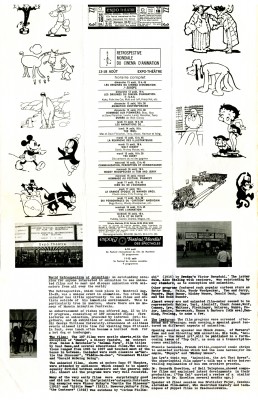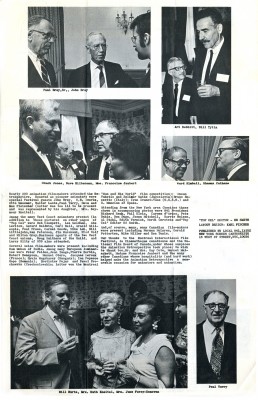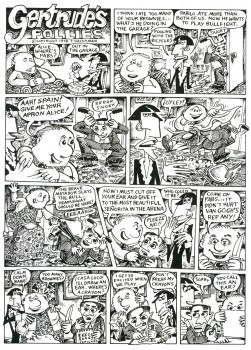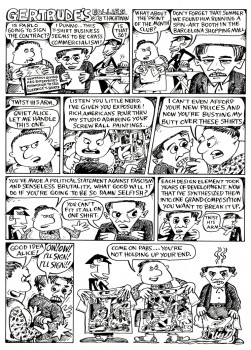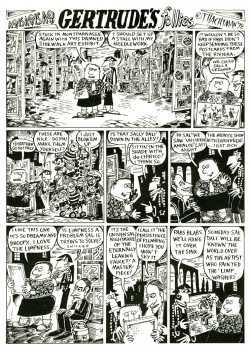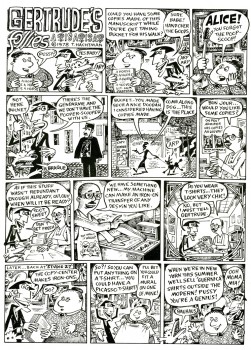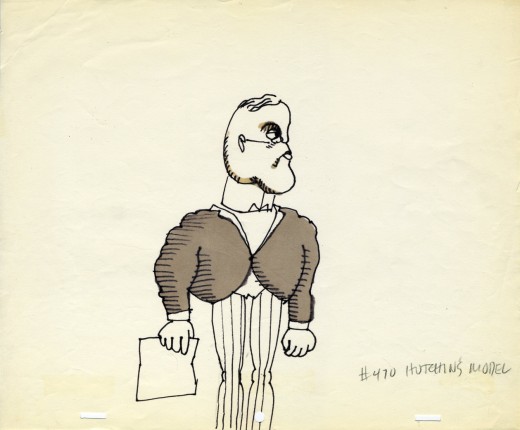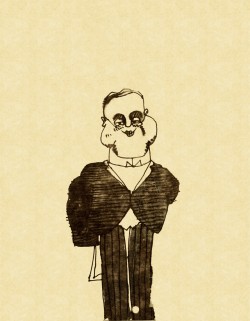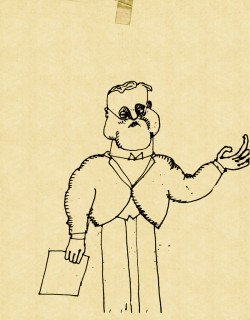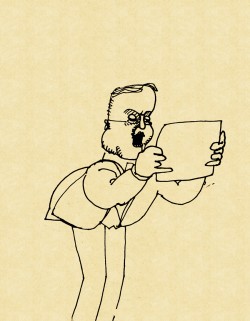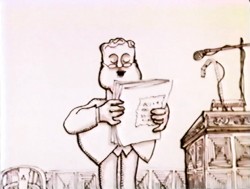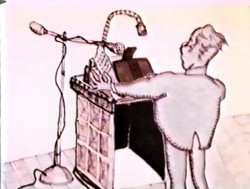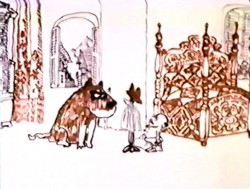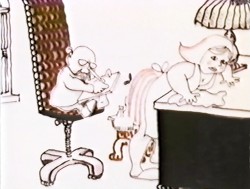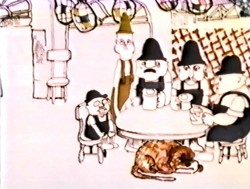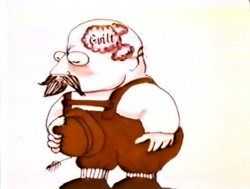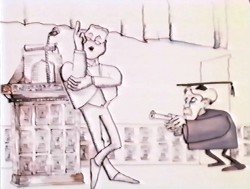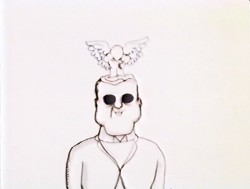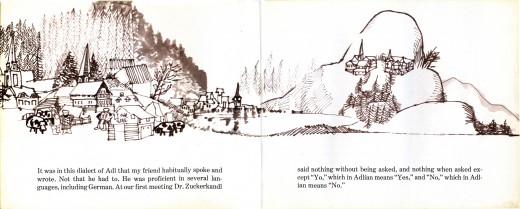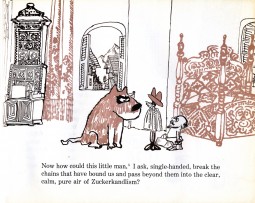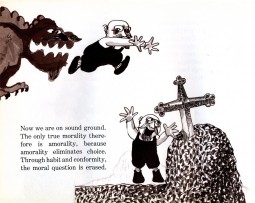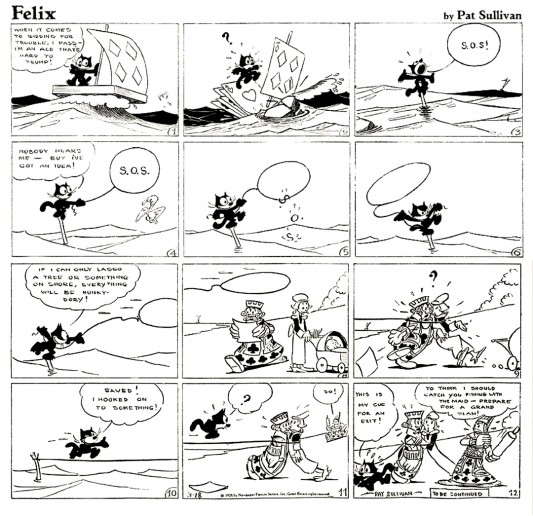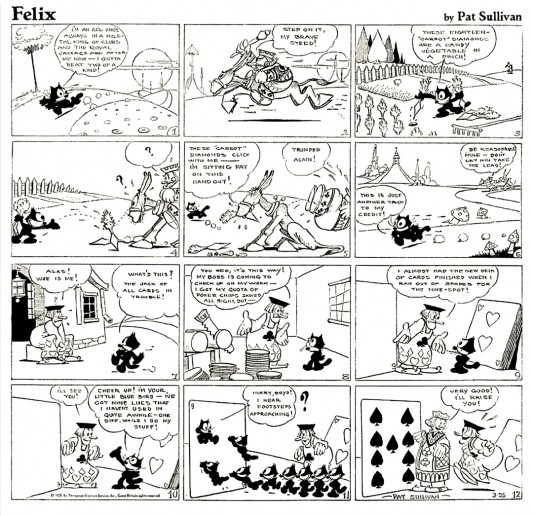Monthly ArchiveNovember 2006
Daily post 30 Nov 2006 09:02 am
Tom Sito Booksigning
- Last night, Tom Sito appeared at a local Barnes & Noble store where he gave a talk and signed books for those that came. The talk was as enjoyable as was expected – Tom always entertains with his humorous mix of stories and history, always given in a personal way.
I took some photos and thought I’d post them, for those who couldn’t make it.
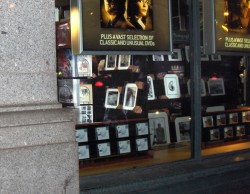 1
1 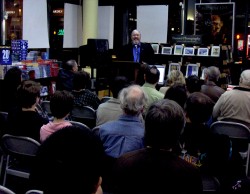 2
2
(Click any image to enlarge.)
1. Outside Barnes & Noble. Tom was just inside the display window. You could watch the talk from the street.
2. There was a nice group of people who showed. It was fun seeing Howard Beckerman again. It’s been a while.
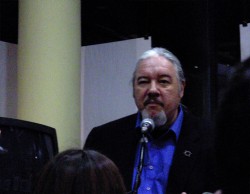 3
3 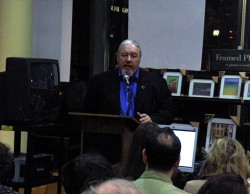 4
4
3. Tom looked good, last night. Being an author obviously agrees with him.
4. Dave Levy asked a question from the audience.
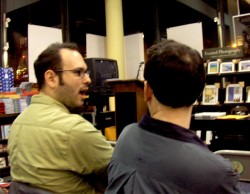 5
5 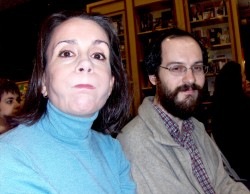 6
6
5. Dave might have been surprised at the answer, or he might have been joking with Chris Boyce before the talk began.
6. With me were Heidi Stalllings pulling a face for the camera and Matt Clinton.
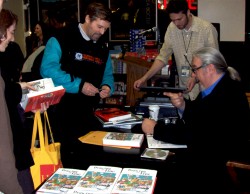 7
7 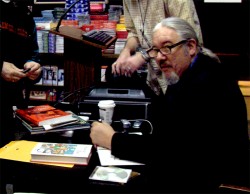 8
8
7. Post talk, there was the signing. Tom takes time with everyone.
8. He returns home to L.A. today. It was nice seeing him again. There are times in NY when you feel separated from the larger animation group, and it’s nice to have some small contact.
Daily post 29 Nov 2006 09:00 am
Sito in person/Pitt on dvd/Canemaker at the Oscars
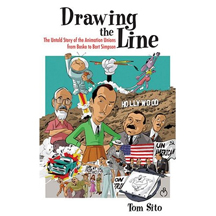 - Tonight Tom Sito will be in New York at the Chelsea Barnes and Noble (675 Sixth Ave, near 22nd Street) to talk about and sign copies of his book, Drawing the Line at 7:00PM. The author, animator, writer, director, producer and great friend will be giving a presentation about the history of animation unions. He’ll offer some real insight into the back door workings of some of the biggest (and smallest) cartoon studios.
- Tonight Tom Sito will be in New York at the Chelsea Barnes and Noble (675 Sixth Ave, near 22nd Street) to talk about and sign copies of his book, Drawing the Line at 7:00PM. The author, animator, writer, director, producer and great friend will be giving a presentation about the history of animation unions. He’ll offer some real insight into the back door workings of some of the biggest (and smallest) cartoon studios.
His book, (official title) Drawing The Line: The Untold Story Of The Animation Unions From Bosko To Bart Simpson, is a unique book with a compelling story for its subject. I read through it in what felt like hours, I was so engrossed, and would suggest anyone interested in animation and its history take a look at it.
At the very least, you should try to make it tonight to meet Tom and hear what he has to say about the subject.
7:00 PM Chelsea Barnes and Noble 675 Sixth Ave, near 22nd Street.
. . . . . . . . . . . . . . . . . . . . . . . . . . . . . . . .
- Suzan Pitt has been making animated films for almost thirty years. In my opinion, her work has always been the closest thing animation comes to “Art.” Not all of the films are easily accessible for the masses, but all of them border on the genius side of film.
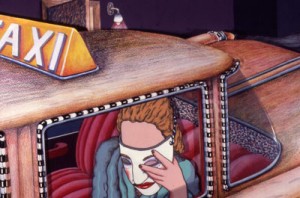 Asparagus was the biggest thing in the Indepedent animation world back in the early ’80s. (The film was completed in 1979.) Hardly a screening of animated films existed without including this short. Hence, I’ve seen the film at least 30 times, and it wears well – though there were times when I became impatient during it. Her films don’t have the haste that today’s animation always seems to strive to achieve. This, to me, is a positive on Pitt’s side. The short played on the circuit, for over two years, opening for David Lynch’s Eraserhead.
Asparagus was the biggest thing in the Indepedent animation world back in the early ’80s. (The film was completed in 1979.) Hardly a screening of animated films existed without including this short. Hence, I’ve seen the film at least 30 times, and it wears well – though there were times when I became impatient during it. Her films don’t have the haste that today’s animation always seems to strive to achieve. This, to me, is a positive on Pitt’s side. The short played on the circuit, for over two years, opening for David Lynch’s Eraserhead.
El Doctor, her most recent film, recently played on PBS this past October. It’s a complex short that takes its time in telling a nightmarish story which plays out in Mexico. 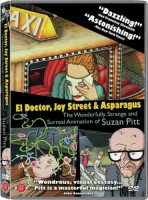 A medley of styles – all inspired by Mexican art – is beautifully and richly animated. Ms. Pitt used a number of talented assistants to reveal this half-hour story. There’s a good article by Chris Robinson on AWN about the making of the film.
A medley of styles – all inspired by Mexican art – is beautifully and richly animated. Ms. Pitt used a number of talented assistants to reveal this half-hour story. There’s a good article by Chris Robinson on AWN about the making of the film.
All of her films have been put together in one dvd released by First Run Features. EL DOCTOR, JOY STREET, AND ASPARAGUS: The Wonderfully Strange & Surreal Animation of Suzan Pitt .
It’s a well produced package that includes the three films plus a new documentary, “Suzan Pitt: Perisitance of Vision”, which explores Pitt’s inspirations, animation techniques, and more.
There’s an excellent review of this dvd by Mark Mayerson on FPS.
 Not included on this disk is the series that she did with R.O. Blechman‘s Ink Tank. Troubles The Cat was done for Cartoon Network’s Big Bag and is one of the most delightful series done recently for television. Designed by Santiago Cohen and narrated beautifully by Maria Conchita Alonso. Go here to see a clip. I’d love to see these shorts collected on one dvd.
Not included on this disk is the series that she did with R.O. Blechman‘s Ink Tank. Troubles The Cat was done for Cartoon Network’s Big Bag and is one of the most delightful series done recently for television. Designed by Santiago Cohen and narrated beautifully by Maria Conchita Alonso. Go here to see a clip. I’d love to see these shorts collected on one dvd.
She has had major exhibitions at the Whitney Museum of Art, the Holly Solomon Gallery in New York, and the Stedlijk Museum in Amsterdam. She has designed two operas in 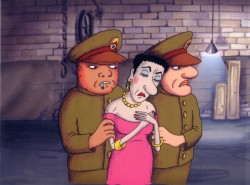 Germany which were the first to include animated images for the stage (Damnation of Faust, and The Magic Flute). In addition, Pitt has created two large multi-media shows at the Venice Biennale and Harvard University. Pitt is the recipient of a Guggenheim Fellowship, a Fulbright Scholar Award, three National Endowment for the Arts Fellowships, and a Rockefeller Fellowship. Her work is in the permanent collection of the Walker Art Center, The Museum of Modern Art, and the Filmmuseum in Amsterdam.
Germany which were the first to include animated images for the stage (Damnation of Faust, and The Magic Flute). In addition, Pitt has created two large multi-media shows at the Venice Biennale and Harvard University. Pitt is the recipient of a Guggenheim Fellowship, a Fulbright Scholar Award, three National Endowment for the Arts Fellowships, and a Rockefeller Fellowship. Her work is in the permanent collection of the Walker Art Center, The Museum of Modern Art, and the Filmmuseum in Amsterdam.
(Click on any image to enlarge.)
. . . . . . . . . . . . . . . . . . . . . . . . . . . . . . . .
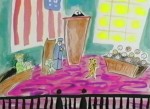 – In case you haven’t seen it yet, Ward Jenkins has posted an absolutely delightful two-part series on
– In case you haven’t seen it yet, Ward Jenkins has posted an absolutely delightful two-part series on
John Canemaker‘s adventures in winning an Oscar.
It’s a day-to-day accounting of what John went through on the way to the microphone. Lots of pictures and a really fun read. Part 1 here. Part 2 here.
Animation Artifacts &Events &Festivals &repeated posts 28 Nov 2006 07:43 am
Montreal Expo 1967 – recap
- Today I’m posting a special issue of Top Cel, the NY animation guild’s newspaper. Dated August 1967, it celebrates the Montreal Expo animation conference and exhibition held that summer. Obviously, this was the place to be that year if you were an animation lover.
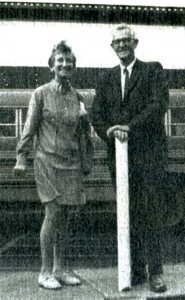 Just take a look at that list of signatures of attendees. Some of them are:
Just take a look at that list of signatures of attendees. Some of them are:
Chuck Jones, Peter Foldes, Manuel Otero, Edith Vernick, Abe Levitow, Don Bajus, Bill & Fini Littlejohn, John Halas, Ward Kimball, Ken Peterson, Shamus Culhane, Carl Bell, Pete Burness, Ub Iwerks, Gerald Baldwin, I. Klein, Gene Plotnick, Ian Popesco-Gopo, Carmen d’Avino, Bill Mathews, Len Lye, June Foray, Bill Hurtz, Spence Peel, Paul Frees, Steve Bosustow, Dave Hilberman, Stan Van der Beek, Les Goldman, Jimmy Murakami, Mike Lah, Robert Breer, Tom Roth, Art Babbitt, Feodor Khitruk, Fred Wolf, Ivan Ivanov-Vano, Paul Terry, J.R. Bray, Walter Lantz, Otto Messmer, Dave Fleischer, Ruth Kneitel, Bruno Bozzetto, Bob Clampett, Karel Zeman, Dusn Vukotic, Bretislav Pojar, Jean Image, Grim Natwick, Tissa David, Barrie Nelson, Andre Martin, Ed Smith, Dick Rauh, and John Whitney.
I guess they don’t make Festivals like they used to. There doesn’t seem to be much written about this event, and I wish some of those in attendance would write about it.
From the Wikepedia entry for Bill Tytla, there’s the John Culhane quote: On August 13, 1967, the opening night of the Montreal Expo’s World Exhibition of Animation Cinema, featured a screening of Dumbo as part of an Hommage Aux Pionniers. Tytla was invited, but worried if anyone would remember him. When the film finished, they announced the presence of “The Great Animator.” When the spotlight finally found him, the audience erupted in “a huge outpouring of love. It may have been one of the great moments of his life,” recalled John Culhane. I’m sure there were many such moments.
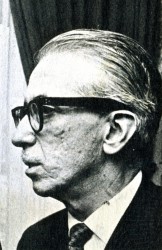 Just to make it all personal, let me tell you a story, although this has nothing to do with Montreal’s Exhibit.
Just to make it all personal, let me tell you a story, although this has nothing to do with Montreal’s Exhibit.
Pepe Ruiz was the u-nion’s business manager. In 1966 – the year prior to this expo – I was a junior in college, determined to break into the animation industry. Of course, I knew the military was coming as soon as I graduated, but I called the u-nion to have a meeting with Pepe. I wanted to see what the likelihood of a “part time job” would be in animation. This took a lot of courage on my part to see what the u-nion was about. I pretty well knew part time jobs didn’t exist. There was no such thing as interns back then.
Pepe was an odd guy who kept calling me “sweetheart” and “darling” and he told me that it was unlikely that I could get something part time in an animation studio.
However he did send me to Terrytoons to check it out.
I met with the production manager, at the time, Nick Alberti. It was obvious I was holding up Mr. Alberti’s exit for a game of golf, but he was kind and said that part time work wasn’t something they did. (He moved on to Technicolor film lab as an expediter after Terry‘s closed. I had contact with him frequently for years later, though I never brought up our meeting and doubt he would have remembered it.) Ultimately, I was pleased to have been inside Terrytoons‘ studio before it shut down shortly thereafter. A little adventure that let me feel as though I was getting closer to the world of animation.
The photos of the Expo are worth a good look. I’ve singled out those above to place around my text. The picture of Tissa and Grim is a nice one of the two of them together.
Ed Smith was the Top Cel editor at the time, and he put together a creative publication.
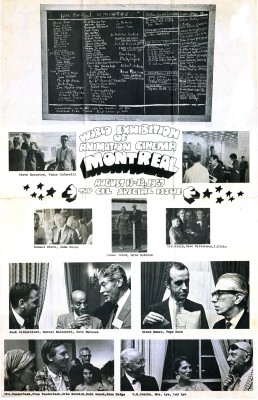 1
1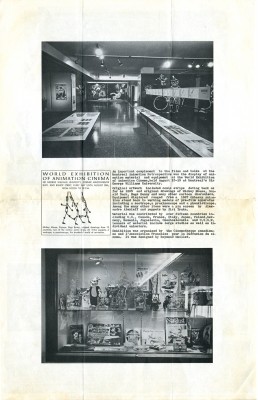 2
2
(Click on any image to enlarge.)
Comic Art &Illustration &T.Hachtman 27 Nov 2006 08:20 am
Gertrude
- Back in the late ’70s, there was a local newspaper that competed with the Village Voice for the alternative audience. The Soho News was smaller and thinner, but had its own treasures. Some good writing and listings, and many excellent alternative comic strips. (Bill Plympton had a weekly strip in this paper before he started animating.)
I fell in love with one comic strip called Gertrude’s Follies to the point where I waited 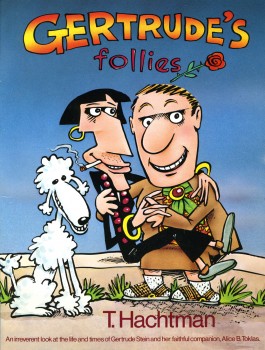 each week for the new issue and the new strip to hit to market. It was about Gertrude Stein and Alice B. Toklas and all the crazies that came into their lives – particularly Picasso, Hemingway and other iconic art types. It didn’t matter that Matisse and Capote didn’t meet; they were both available for the strip – as was everyone else.
each week for the new issue and the new strip to hit to market. It was about Gertrude Stein and Alice B. Toklas and all the crazies that came into their lives – particularly Picasso, Hemingway and other iconic art types. It didn’t matter that Matisse and Capote didn’t meet; they were both available for the strip – as was everyone else.
Finally, after enjoying it for so long, I decided to locate the cartoonist behind it, and see whether he was interested in developing a storyboard and script for a feature. Maybe we could get some low-budget financing.
Tom Hachtman was the cartoonist, and he was a brilliant artist. His wife, Joey Epstein, was another fine artist. The two entered my life at this point, and some interesting things developed.
Gertrude’s Follies was an ongoing project. Tom worked with Maxine Fisher, who has been my writing partner through all the years of my studio. The two of them developed a couple of themes from the mass of strips that had been done and started to weave a storyboard. Tom left 4 or 5 panels of each 6 panel page empty, and I constructed and reconstructed story around them. Sometimes I would draw more material, sometimes I would take some away. It was real fun.
The Soho News folded, and no one really picked up the strip. It ran for a short time in The Advocate. Tom was able to publish a collected book (see the cover above.) You can still locate a rare copy on line.
Some newer, color copies of the strip can be found on line here.
Tom also does some political cartoons for the site here.
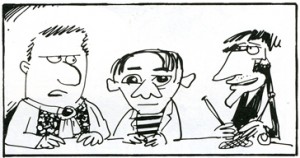 The movie never went into production. I couldn’t raise the funds – my inexperience. We did make one short segment – a two minute piece that was the most hilarious strip. Sheldon Cohen, an animator I met at the Ottawa 76 festival, came to NY when I offered him a job on Raggedy Ann. Sheldon, ultimately, did a number of films for the National Film Board which you can watch on-line if you click on his name.
The movie never went into production. I couldn’t raise the funds – my inexperience. We did make one short segment – a two minute piece that was the most hilarious strip. Sheldon Cohen, an animator I met at the Ottawa 76 festival, came to NY when I offered him a job on Raggedy Ann. Sheldon, ultimately, did a number of films for the National Film Board which you can watch on-line if you click on his name.
Sheldon animated this particularly funny strip. It took a while for him to animate it, and by the time he was finished, the feature had died and I had lost some interest. Years later I inked and painted it and had it shot. The short piece was never finished, though I still think about doing that.
Tom also recently gave me a funny strip about Pablo Picasso sculpture for which I’ve finished a storyboard and animatic. Hopefully, I’ll get the energy to animate it.
Aside from Gertrude, both Tom & Joey worked on a number of my films and still infrequently do. The two have painted many murals on the Jersey Coast, where they currently live. Tom has been a political cartoonist for the NY Daily News, has done lots of airbrush work for Bob Blechman when the Ink Tank was in operation. He also has done quite a few cartoons for The New Yorker magazine.
Here are a few of the strips to give you the flavor. Perhaps next week I’ll give a sample of our storyboard, comparing it with some of the actual strips. Enjoy.
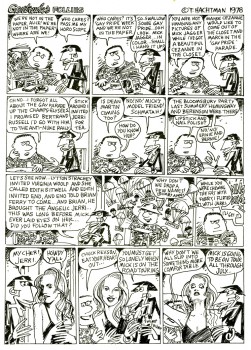 1
1 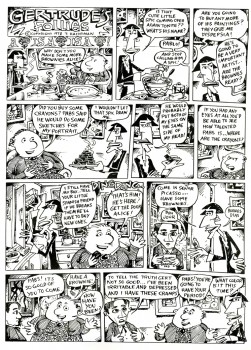 2
2
(Click on any image to enlarge so that you can read the strips.)
Photos 26 Nov 2006 07:53 am
Abel Photo Sunday
– Generally I like to keep Sundays specifically for posting photo memorabilia, but before going onto that, I wanted to point to an article in today’s NY Times  about a documentary about the Chicago 8 that is using animation (well, not animation – mocap). The artwork is being done by NY’s Curious Pictures.
about a documentary about the Chicago 8 that is using animation (well, not animation – mocap). The artwork is being done by NY’s Curious Pictures.
Now, onto the photographic past.
- As we approached the end of Abel’s Island, Robert Marianetti was set to leave to return to Los Angeles. We had a small toast and took this photo of the group in the studio. This was our 38th Street studio, in 1988, just prior to our moving to the larger Broadway location in Greenwich Village.
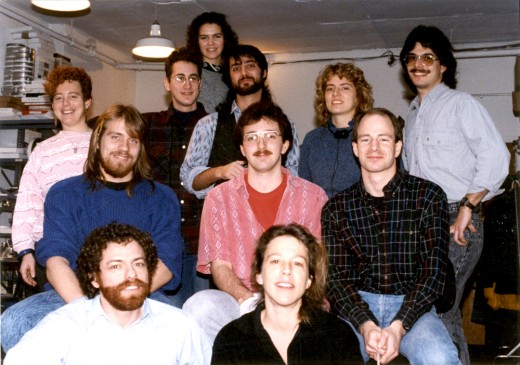
Cast of characters – Back row (L to R): Betsy Bauer (colorist), Ray Kosarin (asst animator/colorist), Laura Bryson (behind Ray) (colorist), Robert Marianetti (Prod Mgr), Theresa Smythe (colorist), Mike Wisniewski (asst animator/colorist)
Center row (L to R): Steve MacQuignon (colorist), George McClements (asst animator/ colorist), Greg Perler (editor)
Bot Row (L to R): me, Bridget Thorne (Bg’s)
Not pictured in the photos is Kit Hawkins, my assistant, who took them.
The categories listed are those for Abel’s Island only. All of these people rose into other postitions along the way. Ray Kosarin, for example, went on to animate and supervise animation. Theresa Smythe animated; Laura Bryson did the bulk of the backgrounds for The Red Shoes. Except for Betsy Bauer (who went on to become a successful fine artist), everyone eventually moved into some greater role in the studio.
There were others who worked outside the studio that didn’t make it into the photograph and others who just weren’t there that day: Tissa David, John Dilworth, Doug Compton, Christine O’Neill, Steve Dovas, and Lisa Crafts.
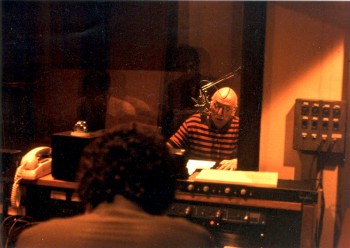 too few are the photos I have of the recording sessions done for the films. On Abel, I have just two. Both are of Lionel Jeffries who played Gower, the frog.
too few are the photos I have of the recording sessions done for the films. On Abel, I have just two. Both are of Lionel Jeffries who played Gower, the frog.
Mr. Jeffries is a very big name in England and deservedly so. Americans probably remember him best for his performance as “Grandpa Potts” in Chitty Chitty Bang Bang or as Pellinore in Camelot. In England, his reputation as a 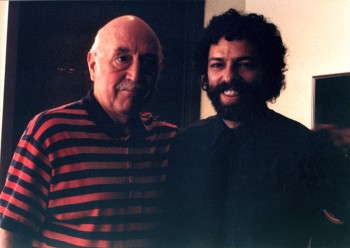 director was sealed with The Railway Children, an overwhelming success in that country. In this film, he directed Jenny Agutter in her first role. (I worked with her on my short, Max’s Christmas.)
director was sealed with The Railway Children, an overwhelming success in that country. In this film, he directed Jenny Agutter in her first role. (I worked with her on my short, Max’s Christmas.)
Mr. Jeffries, like all of the Brits I have worked with was extraordinarily professional. The session was relatively brief, and the performance was more than I ever imagined.
(All images enlarge by clicking on them.)
My biggest regret, on this film, was that I didn’t take a camera to London to snap shots of Tim Curry. His performance as Abel was the rock on which the rest of the film was built. Lionel Jeffries‘ voice worked well with Tim Curry‘s. The only other voice heard in that 1/2 hour show, was Heidi Stallings‘. She also gave a solidly first rate performance as Abel’s wife, Amanda. (No photos of that session either!)
Sterling vocal performances from all three actors really pushed the film off on a good journey.
Animation &Mary Blair 25 Nov 2006 08:37 am
Mastercard Sherbet
 – An animated commercial, Mastercard – Full House was introduced last year during the holiday season. It’s making it back this year in a slightly larger way. I noticed this spot had been revived when it first started airing before Thanksgiving.
– An animated commercial, Mastercard – Full House was introduced last year during the holiday season. It’s making it back this year in a slightly larger way. I noticed this spot had been revived when it first started airing before Thanksgiving.
The ad was produced in England for McCann Erickson by the production house, Sherbet, a company set up in 1996 by producer, Jonathan Barstow, and director, Jonathan Hodgson. The company has won many international film awards including a BAFTA for best animation in 2000 for Hodgson’s short film, The Man With The Beautiful Eyes. Billy Crudup does the VO for the spot which AdWeek awarded with a “Spot of the Month.”
Go here to see the animated ad.
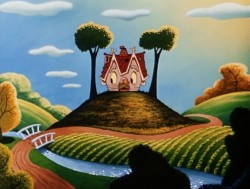 The spot originally caught my eye last year because it feels so much like the Disney short, The Little House, very much a product of Mary Blair’s design.
The spot originally caught my eye last year because it feels so much like the Disney short, The Little House, very much a product of Mary Blair’s design.
Amid Amidi wrote about it on his Cartoon Brew site and that led to the Sherbet site.
To me, the color design of this commercial doesn’t feel at all like Mary Blair’s work, although the film obviously was an influence. The charm of the spot is in the very modern approach taken while giving a retro nod to the classic short.
The director and designer of the spot was Sarah Roper, and the Animation Director was Robin Shaw. The Sherbet site gives only this information about Ms. Roper:
Sarah’s work is characterized by her elegant use of collage. She creates charming and appealing characters and has a great feeling for shape, texture and color. Her short film The Apartment Cat and her United Airlines commercial Legs use body language and facial expression to tell warm and witty stories.
She studied animation at the Royal College of Art. There, she worked with a personal technique using rubber stamps. In 1993, she won the MTV Free Your Mind competition. She did other shorts including Chicken Wire and animated for Astley Baker Davies on 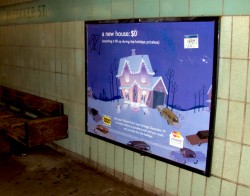 Peppa Pig and on Mark Baker’s The Jolly Roger, prior to joining Sherbet.
Peppa Pig and on Mark Baker’s The Jolly Roger, prior to joining Sherbet.
The commercial has made a comeback of sorts. It’s not only on television, but the campaign has grown to signage about town. Posters featuring an image from the ad are in the NYC subway system (it’s hard to find one that doesn’t have graffiti or a sticker pasted onto it.) I have to assume that they’re not only advertising in NYC, but that posters appear elsewhere. High honors for an animated spot.
(Click on any image to enlarge.)
Hubley &Models 24 Nov 2006 08:27 am
Zuckerkandl Models
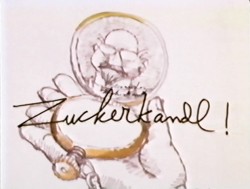 - One of my favorite Hubley shorts is a lesser known film, Zuckerkandl.
- One of my favorite Hubley shorts is a lesser known film, Zuckerkandl.
It is an animated version of the satirical lecture Robert M. Hutchins gives annually to discuss the life and philosophy of the fictitious Dr. Alexander Zuckerkandl and his philosophy that the goal of life is to get through it without feeling, in the belief that true happiness can be achieved only by becoming unconscious of our conscious.
The life and philosophy of Zuckerkandl is depicted and constructed.
I also have a couple of models of the speaker, Hutchins, done by John Hubley and I’m posting them here.
The following are frame grabs (from not the best copy of the film.)
The film was also made into a book. It’s illustrated with images from the film that have been reshaped. Here are a couple of them. The colors in the book are probably closer to the actual film.
Daily post 23 Nov 2006 08:02 am
Thanksgiving w/o Robert Altman
- I wish you all a happy Thanksgiving day.
Another cinematic star has left us this year, and I want to take this opportunity to give thanks for all the brilliant film work he’s given us.
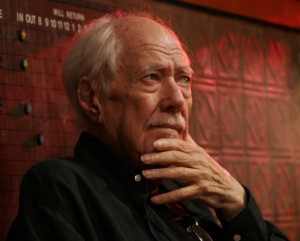 – Robert Altman died Tuesday, November 21, 2006. I wanted to post some thoughts yesterday, but wasn’t able to do justice to the man in so short a time. Please forgive my rambling thoughts on the man, but I want to say something about his landmark career and the influence it has had on me.
– Robert Altman died Tuesday, November 21, 2006. I wanted to post some thoughts yesterday, but wasn’t able to do justice to the man in so short a time. Please forgive my rambling thoughts on the man, but I want to say something about his landmark career and the influence it has had on me.
Robert Bernard Altman was born on Feb. 20, 1925, in Kansas City, Mo. He worked in Kansas City doing small training films before moving to Hollywood. There, he did a lot of television work on shows ranging from Alfred Hitchcock Presents,†“Maverick,†and “Peter Gunn,†to “Bonanza,†and “Route 66.†Once he did his first film, Countdown, starring James Caan and Robert Duvall, he was on an express track. That film was shot on a very low budget and led to others including his breakthrough film, M*A*S*H.
The success of M*A*S*H. brought a bit of money and power and allowed him to do other projects such as Brewster McCloud, which was as far away from mainstream as you’ll get. He was able to do at least a film a year, and often two, right up to his death. Released only this Summer was A Prairie Home Companion which starred the diverse cast of Meryl Streep, Lily Tomlin, Lindsay Lohan and Woody Harrelson.
It’s wonderful to be a New Yorker. So often you’ll pass celebrities on the sidewalk or see them in restaurants and other moments of yours (and their) normal life. Over the years, I’ve seen Robert Altman on the street at least half a dozen times.
The first time we passed was back in the 70′s as I was entering a screening of some Anime films, he was exiting the screening room. I held the door open for him, dressed in a rust-colored buckskin jacket with fringe-a-plenty and a cream-colored cowboy hat.
The last time I saw him was in August at a theater when I saw the play, The History Boys, on Broadway. He sat a couple of rows behind Heidi and me and looked as if he enjoyed the play, though he didn’t look particularly comfortable.
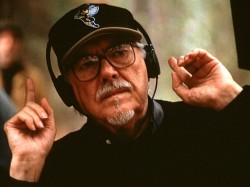 For so long, I truly respected what he did and always sought out his films, but I didn’t always enjoy the experience. I loved his use of sound and overlapping dialogue, his mobile camera and intentionally casual approach. And such great acting – always. The films, themselves, weren’t always entertaining, to me, – except on a technical level. Too often they were self-conscious or self-important.
For so long, I truly respected what he did and always sought out his films, but I didn’t always enjoy the experience. I loved his use of sound and overlapping dialogue, his mobile camera and intentionally casual approach. And such great acting – always. The films, themselves, weren’t always entertaining, to me, – except on a technical level. Too often they were self-conscious or self-important.
However, that all seemed to change around the time of The Player and even before that there were exceptions for me:
Three Women was intelligent, different, well-acted and had a brilliant score by Gerald Busby. The visual look was stunning.
Popeye had first rate performances by Robin Williams and Shelley Duvall, beautiful songs by Harry Nilsson, and a great score by Van Dyke Parks.
Short Cuts was brilliantly acted with virtuoso performances by Madeleine Stowe and Julianne Moore. It was an incredibly literate and articulate adaptation of Raymond Carver‘s short stories.
Gosford Park had a brilliant script by Julian Fellowes and outstanding ensemble acting by a large cast of Britain’s finest actors. It smashed the Masterpiece Theater mold while mimicking it.
The Player took Hollywood filmmaking apart piece by piece and had fun doing it. The script by Michael Tolkin was wonderful, and all the elements came together to make a dark, enjoyable romp for Altman.
The key to Altman, for me, was that with very few exceptions he made films that wouldn’t have been made otherwise. As a matter of fact, with his death, a reliable source of cinematic “Art” is lost to us. Even his slightest film, such as The Company, would never have seen the light of a projector.
This is not something you can say about many directors.
He also supported new talent and enabled many to get their start in film. Shelley Duvall, Keith Carradine, Cynthia Nixon, Alan Rudolph and so many others jump-started their careers in Altman’s films. Actors, in fact all talent wasl treated like gold, and he used every ounce of all the talent around him on the set. This, in film, is a rarity. If only for that he should be applauded.
A.O.Scott has a good appraisal of Mr. Altman’s work in yesterday’s NYTimes.
The obituary by Rick Lyman is also well written.
Jaime J. Weinman wrote a nice piece on Tuesday.
Animation Artifacts 22 Nov 2006 08:05 am
Silent Thoughts & Felix
- Felix the Cat was a remarkable series in the era of the silent cartoon.
Other than Felix, there were few interesting film series.
Among the best were the Dinky Doodle films 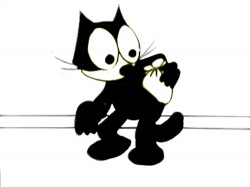 of Bray/Walter Lantz and the odd, rotoscoped Koko films of the Fleischer brothers.
of Bray/Walter Lantz and the odd, rotoscoped Koko films of the Fleischer brothers.
Most of the films in theaters were horrible: the tedious Col. Heeza Liar films of J.R.Bray, the tiresome, repetitive and endless Aesop Fables of Paul Terry, the Hearst recycled comic strips, and the Disney Alice films which stole from the worst of them (the Terry cartoons.) Disney improved substantially with some of the Oswald films.
In this lot, the Felix films were enormously creative and entertaining.
(Click on any image to enlarge.)
Pat Sullivan still gets credit for the character, but it is well known that Otto Messmer was responsible for putting him on the screen. Messmer and his animators imaginatively used the medium with graphic nuance and ingenious wit.
Don’t get me wrong; these films are still bordering on the unwatchable today. But back in the early Twenties, they had to have stood out from the pack. Felix would remove his tail to use for some other need. He’d take type out of the screen balloons to use for graphic gags. 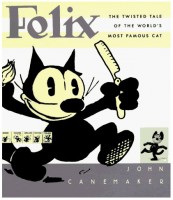 It often was quite clever how they manipulated the visuals for Felix to find his anmated deus ex machina.
It often was quite clever how they manipulated the visuals for Felix to find his anmated deus ex machina.
Of course, the book to read all about Sullivan, Messmer and Felix is John Canemaker’s Felix: The Twisted Tale of the World’s Most Famous Cat.
Unfortunately, the comic strips – which were often done by Otto Messmer as well – didn’t exploit this graphic sensibility well. Poring over a number of strips to find something to illustrate my point, I didn’t have the easiest of time locating the imaginative graphics that the animation always exploited.
Here, I give you two Sunday pages which do take advantage of the visuals around him.
Animation Artifacts &Daily post 21 Nov 2006 07:46 am
Norman McLaren At MOMA
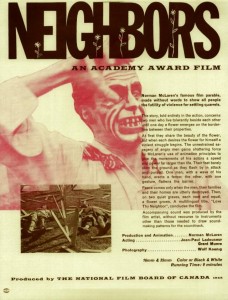 – The Museum of Modern Art will be celebrating the pioneering work of Norman McLaren by screening some newly stuck 35mm prints of some of his key works.
– The Museum of Modern Art will be celebrating the pioneering work of Norman McLaren by screening some newly stuck 35mm prints of some of his key works.
This also celebrates the recent issuing of a new DVD set of McLaren’s complete works by the National Film Board of Canada.
Norman McLaren: Master’s Edition
MoMA will present this eleven-film program on Nov.29th and 30th, which demonstrates the imagination, vitality, and versatility of the artist’s animation.
The program includes Opening Speech, Stars and Stripes, Hen Hop, Begone Dull Care, A Chairy Tale, Lines Horizontal, Blinkity Blank, La Merle, and Neighbors.
 I urge you to attend since there aren’t often screenings of these films in 35mm. Maybe it’s just me, but somehow, it doesn’t feel the same in dvd or ipod.
I urge you to attend since there aren’t often screenings of these films in 35mm. Maybe it’s just me, but somehow, it doesn’t feel the same in dvd or ipod.
We’re living in a world where everything has to be handed to us. When an artist, such as McLaren, comes along with films that are slightly abstract and force us to use our imaginations, films that have a strong intellectual content, we have to bask in the glow and absorb the inspiration.
(Images enlarge by clicking them.)
Wednesday, November 29, 6:00;
Thursday, November 30, 8:30.
The Celeste Bartos Theater
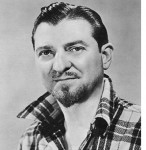 – To move to an artist of a different sort, I received a comment on my Splog (original post here) from Thaddeus Seymour who is the son-in-law of TV art instructor, Jon Gnagy. I’d written a post about Gnagy and talked about the impression that his art instruction made on a young me.
– To move to an artist of a different sort, I received a comment on my Splog (original post here) from Thaddeus Seymour who is the son-in-law of TV art instructor, Jon Gnagy. I’d written a post about Gnagy and talked about the impression that his art instruction made on a young me.
Thaddeus wanted to announce that he and wife, Polly, have put together a new site memorializing Gnagy which includes ten episodes of his show in YouTube format. Manna from heaven.
This may serve as a trip down memory lane for many; it may serve as art instruction for others. Either way it’s entertaining and informative about a television program that was big in the 40′s & 50′s.
Go here for the site.
Go here to order a Jon Gnagy kit.
Thank you Thaddeus and Polly Seymour.
